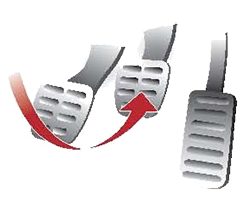| PROBLEM | PROBLEM CAUSE | CORRECTIVE ACTION | |
|---|---|---|---|
|
BREAK DRAG
|
Sticking brakes may be failing to release rightly. | Brakes adjusted excessive tight, Master cylinder by-pass portblocked. Slightpedal return spring, Deformed backing plates, Sticky wheel cylinder. | Readjust and approve sufficient clearance between lining and drum. Clear blockage. Set up new springs. change with new plates, Repair with new cups. |
|
BRAKE GRAB
|
“Touchy” brakes that catch with least pressure. | Pollution of pads or linings with brake fluid, oil, grease, etc. Caliper not alied with disc. Mounting bolts loose. | Clean or change pads or linings. Accurate alignment. Tighten to designated torque Repair or change. Free up and replace if damaged. |
|
BRAKE NOISE
|
Brakes should work with minimal amount of noise. But excessive squeal, screech, groaning, grinding chatter or rattle means your brakes need attention. | Too much lateral wear and tear of rotor. Worn pads or linings. Twisted brake shoe. Fragile or broken spring components. Drums out of round. Free wheel bearing. Alien particles embedded in material. Defective caliper alignment. | Accurate run out to manufacturers spec. Change with new pads or linings. Change brake shoes. Change with new springs. Turn or change drums. Adjust or change faulty parts. Replace with new pads or linings. Readjust. |
|
BRAKE NOISE
|
Car pulls to one side when brakes are applied, | Pollution of pads or linings with brake fluid, oil, grease, etc. Incompatible pads or linings, Defective caliper pad alignment. Unequal brake adjustment. Seized calliper. | Clean or change pads or linings. Change with correct parts. Check for free caliper mounting bolts, guide pins, broken clips. Readjust all brakes. Check both calipers(ie,pin and Sealkits) on that axle. |
|
BRAKE WEAR
|
Premature wear can be caused by a number of fa ults in the brake system. To prevent costly repairs have the brakes checked at least once per year | Incorrect type of pad or lining material for working conditions. Caliper pistons and / or pins Seized. Very rough rotor surface. | Change with correct pad or lining material for application. Fit pin and sealkits. Regrind rotors. |
|
HIGH PEDAL FORCE
|
Excessive stopping distance, excessive pedal effort, brakes do not react rightly. | Wom / glazed pads or linings. Frozen calipers or wheel cylinders. Brake booster break down. | Change with new pads or linings. Free up and change if necessary. Check booster Assy. Repair as required. |
|
LOW / SPONGY PEDAL
|
Pedal almost touches floorboard before brakes operate. No brake reserve. | Lack fluid in master cylinder. Excessive free play in brake pedal linkage. Padrejection, Excessive clearance between linings and drums. Contaminated fluid. Residualine pressure valve faulty. Air in hydraulic system. | Check system for fluid leak and repair. Adjust for correct linkage. Check rotor run out and parallelism, bearing adjustment, etc. Adjust brakes. Change with approved brake fluid. Check / change bleed brake system. |
|
VIBRATION
|
Brake pedal, steering wheel or Whole wheel shakes, vibrates or pulsates when brake is applied. | Rotor run out and parallelism. Wear in steering and suspension components. Wheels out of balance. | Resurface disc brake rotors. Check and change wom components. Wheel balance required. |








